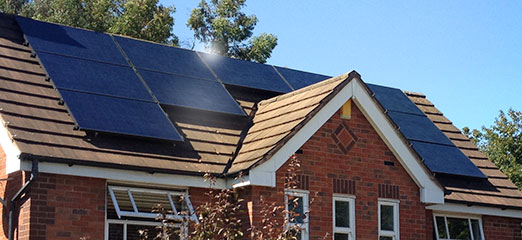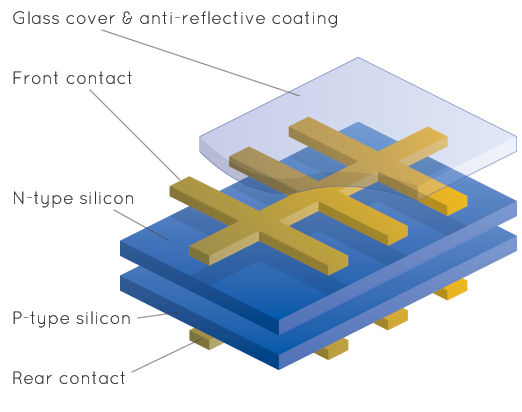The type of solar panel you normally see on people’s roofs are called Photovoltaic Solar Panels — photo meaning light, and voltaic meaning to do with electricity. As the name suggests, Photovoltaic (or PV) panels convert light directly into electrical energy. So how do they work? How much sunlight do they need? And most importantly, is it sunny enough for them to work in the cloudy UK?
The Photoelectric Effect
PV solar panels produce your electricity using something called the photoelectric effect. The photoelectric effect was first noted back in 1839 by a French physicist named Edmund Bequerel. He discovered that certain materials would produce a small electric current when you exposed them to light. This is the principle used by PV solar panels. The first practical applications of PV solar panels were on space craft in the 1960s. As time went on, the technology improved and the panels became smaller and cheaper. Today solar panels are affordable and efficient enough for domestic use.
What Is A Solar Cell?
Solar cells are small devices which can convert sunlight into electricity. One cell on its own will only provide a very small amount of power. Several cells connected together and fixed in a frame make a solar panel (or a module), which can produce a larger, useful amount of power. When several panels are connected together you have a solar array.
How Do Solar Panels Work?
Put simply a solar cell works like this: Inside a solar cell you have two wafer-thin layers of silicon crystal, placed on top of each other to make a sort of silicon sandwich. The top layer has been specially treated so that its atoms are unstable — they have one too many electrons that they would really like to get rid of. The bottom layer has also been treated, but this time the atoms have a few empty spaces that could really do with an electron to fill them. So the top layer is desperate to lose a few electrons, the bottom layer is desperate to gain a few electrons, and the electrons themselves are itching to move from the top layer to the bottom. This setup puts everything is in place for electricity to be produced. There is just one problem: the electrons within silicon crystal can’t move around freely — not until the solar panel is exposed to light.
The inside of a solar cell. As photons of light hit the top layer, it allows electrons to flow from the top layer to the bottom, creating a current.
When sunlight hits the top silicon layer, it ‘excites’ the electrons and gives them enough energy to move. The electrons begin to flow from the top layer to the bottom. And as we know, when a bunch of electrons start to move along in the same direction, we have electricity. Put two metal contacts on either side of the silicon sandwich and we have electricity moving through a circuit.
There is one last piece to the puzzle before the electricity can be used. The electricity generated by PV solar cells is DC (direct current). The electricity used in your house is AC (alternating current). So the current from the solar panel system has to go through an inverter, to convert it from DC to AC before it can be pumped into your house and used to run appliances.
(This is only a simplified version of how it works for non-technical types. You can read a much more in-depth scientific explanation here.)
Do Solar Panels work in the UK?
Solar panels harness clean energy from a virtually limitless supply. Great then — if you live in Australia. But is there enough sunshine in Britain to make it worth investing in a solar panel system? The short answer is yes. The good news is that despite our unpredictable weather, the sun doesn’t have to be out for solar panels to work. As you would expect, they produce more power on a sunny day, but they will still produce some energy on a cloudy day — the more light there is, the more they produce. And remember, PV solar panels use light to produce electricity, not heat.
The UK receives a comparable amount of sunlight to Germany, one of the biggest markets for photovoltaics in the world. Full-size map here.
Although Britain can’t compete with the likes of Spain or Africa, the southern part of the UK receives a similar amount of sunlight to Germany — one of the world leaders when it comes to solar power. You may also be interested to know that by the end of 2011, there were around 230,000 solar power projects in the UK. Our government introduced the feed-in tariff in 2010 in order to encourage solar power, and although the rate was recently reduced, you can still make a very reasonable return on your investment whilst saving the planet.
To calculate how much power (and money) your home could produce, see our table here.





2 Replies to “How Solar Panels Work – A Guide For Dummies”
Comments are closed.